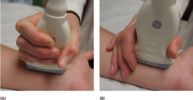Or ask
@DrAmir0078 to send you one of his 3D printed needle guides!
Thanks for the mention Dr.
@nimbus ; I will be more than happy to help and send you the sample I created for beginners for this purpose from Baghdad Iraq, hopefully will fit in your probe as it works for Ezono linear probe and I am not sure would fit in your OR probe model.
If you want to see the design, you can hire a 3D printer geek to make you one with suitable materials and make sure of providing the hygiene, or you can use it as disposable (it won't cost a lot per piece).
Here is the guide USGNAD I created and there are a thread in the private forum too about it.
It really helps in your first TAPs...
Beside, if you have simulation labs or an US machine you can play with, bring a raw chicken - fresh not frozen - and try in plane with it in different angles and follow the up pictures of how to fix your hand and the probe.
Or you can buy online from Civco company (Ultra-Pro II

In-Plane Ultrasound Needle Guides-Multi-Angle) and there are plenty of such products out there depending on the probe - device model !
It will be easy with the time !
Peace out


 In-Plane Ultrasound Needle Guides-Multi-Angle) and there are plenty of such products out there depending on the probe - device model !
In-Plane Ultrasound Needle Guides-Multi-Angle) and there are plenty of such products out there depending on the probe - device model !